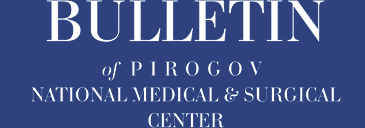Authors
Krasenkov Yu.V., Tatyanchenko V.K., Sukhaya Yu.V., Bogdanov V.L.
FGBOU VO RostGMU, Rostov-on-Don
Abstract
Introduction: chronic compartment syndrome (CCS) developed after surgical treatment of intermuscular phlegmon of the upper limb is a common pathology that has a significant negative impact on the quality of life of patients in the late postoperative period.
Objective: to develop an algorithm for the diagnosis and prevention of postoperative tissue hypertension (CTS) in patients with phlegmon of the upper limb.
Materials and methods: results of treatment of 134 patients operated on for intermuscular phlegmon of the upper limb (IMUP) (shoulder and forearm segments). Patients were divided into 2 comparable clinical groups, the difference between the groups was as follows: Group I – treatment using known technologies; Group II – treatment using original technologies (Patent of the Russian Federation № 2699964, № 2755388, № 2695367). They included diagnostics of tissue pressure, complex surgical treatment of compartment syndrome, prevention of myofascial dysfunction and postoperative tissue hypertension.
Results: аfter complex surgical treatment of the MFCI (shoulder, forearm) and compartment syndrome, chronic tissue hypertension may persist, which can have a negative impact on the patient’s quality of life with its clinical manifestations. In the postoperative period, it is necessary to monitor tissue pressure in order to determine the tactics of combating it.
Conclusions: The developed algorithm for the prevention of tissue hypertension has proven its effectiveness and can be recommended for use in purulent surgery departments.
Keywords: chronic compartment syndrome, tissue hypertension, phlegmon, rehabilitation.
References
1. Beddard L, Roslee C. Acute compartment syndrome. Surgery (Oxford). 2023; 41(4): 223-226.
2. Jakob DA, Benjamin ER, Demetriades D. Extremity Compartment Syndrome. Textbook of Emergency General Surgery: Traumatic and Non-traumatic Surgical Emergencies. Cham: Springer International Publishing, 2023. Р.1663-1678.
3. Miciak M, Jurkiewicz K. Compartment syndrome-a complex and insidious medical problem. Journal of Pre-Clinical & Clinical Research. 2023; 17(2).
4. Sharma N, Sharma NM, Sharma A, Mirza S. Comparison and convergence of compartment syndrome techniques: A narrative review. Expert Review of Medical Devices. 2023; 20(4): 283-291.
5. Moon C. Compartment Syndrome. Orthopedic Trauma Call for the Attending Surgeon. CRC Press. 2024. Р.49-52.
6. Velasco TO, Leggit JC. Chronic exertional compartment syndrome: a clinical update. Current sports medicine reports. 2020; 19(9): 347-352.
7. Hirardot T, et al. Diagnostic criteria of forearm chronic exertional compartment syndrome: a systematic review. Orthopaedics & Traumatology: Surgery & Research. 2024: 104001.
8. Vajapey S, Miller TL. Evaluation, diagnosis, and treatment of chronic exertional compartment syndrome: a review of current literature. The Physician and sportsmedicine. 2017; 45(4): 391-398.
9. Lui B, Barrazueta G, Ruschelsman DE. Chronic exertional compartment syndrome in athletes. J. Hand. Surg. 2017; 42: 917-23.
10. Malik GR, Vyas KA. The pressure is rising: evaluation and treatment of chronic exertional compartment syndrome. Current Sports Medicine Reports. 2023; 22(6): 204-209.
11. Long B, Koyfman A, Gottlieb M. Evaluation and management of acute compartment syndrome in the emergency department. The Journal of emergency medicine. 2019; 56(4): 386-397.
12. Patent RUS №2699964/ 11.09.2018. Byul. №26 Byakova EN, Krasenkov YuV, Tatyanchenko VK, et al. A method for diagnosing intermuscular phlegmon of an extremity. (In Russ.)
13. Patent RUS №2755388/ 15.09.21. Byul. №4. Krasenkov YUV, Tatyanchenko VK, Pan¬chenko DV, et al. A method for preventing myofascial dysfunction in the treatment of deep intermuscular phlegmon of the extremities in the postoperative period. (In Russ.)
14. Patent RUS №2695367/ 23.07.2019. Byul. №21. Krasenkov YuV, Tatyanchenko VK, Voloshin RN, et al. Method of preventing tissue hypertensive syndrome in the treatment of soft tissue phlegmon in the postoperative period. (In Russ.)
15. Vogels S, Ritchie ED, Bakker EWP, et al. Measuring intracompartmental pressures for the chronic exertional compartment syndrome: challenging commercially available devices and their respective accuracy. Journal of Biomechanics. 2022; 135: 111026.


